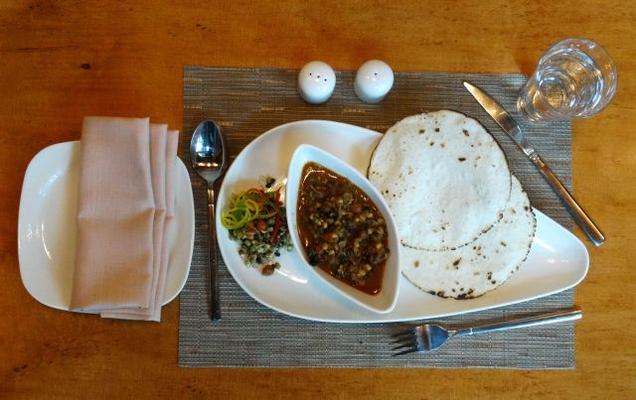
At the Kodava food festival, Susanna Myrtle Lazarus learns that there’s more to the cuisine than pork
“Pandi (pork) curry does not define Coorg cuisine even though it is what we’re most famous for,” says Smitha Kuttayya, a native of Coorg. The statement is a little hard to believe, but the spread at Clubhouse, the all-day diner at Taj Club House, makes it clear that she isn’t far off the mark.
A collection of signature Kodava recipes curated by Chef Naresh from Vivanta by Taj – Madikeri, includes koli chuttadh (chicken marinated with spices and griddled), kummu (mushroom)soup, toppu palaya (traditional curry with fresh double beans) and akki (rice) payasam among other regional favourites. Being from the region, Smitha has partnered with the hotel to consult on the food and interact with diners about Kodava cuisine.
Smitha says that the food is influenced heavily by Kerala cuisine: “We also use a lot of coconut and rice in our food. It’s basically a farmers’ mentality to use everything we grow in the food we eat. And so we have varying degrees of rice – the fine, broken grains that are found after the dehulling process is used to make dumplings called kadumbuttu, the medium-sized grains are used to make paputtu.”
Kodava cuisine is also very seasonal, says Smitha, who has draped her sari in the very elegant Coorgi way. “During Aadi — we call it kakada — the rains are the heaviest. There is a particular plant that is normally considered a weed; it grows all over the place throughout the year. The 18th day of this heavy rain is the only day when that plant has a particular taste and it is gathered and made into dark, almost blackish syrup called madhu thoppu,” she says. This plant is believed to have 18 medicinal properties and is incorporated into payasams or puttus.
As we speak, steaming hot attukal soup (peppered lamb shank) is brought to the table along with kadumbuttu seasoned with spices. Smitha says that the kadumbuttu should be had with ellu kanji, which is a sort of chutney made with roasted sesame seeds. The steamed dumplings are addictive. “No Kodava wedding will take place without this dish being served. The women of the house sit together the day before the wedding and roll out the balls to be steamed. If they’re not of the right consistency, they will become a congealed mass of boiled and steamed rice,” she says, adding that they are served plain at weddings.
Going beyond pork curries, Kodava cuisine uses vegetables and fruits like pumpkin and raw banana. The kari bale cutlets are roasted raw banana patties that are crisp on the outside and soft inside. Mushrooms are plentiful and each distinctive kind is used in different ways; the small ones are usually pickled or made into a curry, and each type is cooked separately. Smitha also talks about a certain type of grapefruit called kaipuli which can’t be found anywhere else. Apparently it is not sour as the name suggests, but can be made into jam, marmalade, juice and it can be burnt to make chutney as well.
For the main course, Tarkari pulao (bright yellow rice with vegetables) and akki ooti (rice roti) are served with koli curry that has a distinct, yet not unpleasant, taste of coconut oil and molai kuru that is mixed sprouts curry.
The picturesque hill district is known for its spice plantations and according to Chef Naresh, it is this that gives the Kodava cuisine its distinct flavour. “I used a special blend of spices — coriander seeds, cinnamon, and cloves — all from Coorg. These are used in all the dishes. Slow roasting for a long period of time gives the dishes like pandi curry their distinct colour — they are dark, but not burnt. The flavours come through more strongly without the spiciness,” he says.
Incorporating cardamom into caramel custard gives the soft dessert a lovely scent and the subtle flavour brings to mind the hills on which the spices were grown. The traditional akki payasam is not overly sweet but is a satisfying end to the meal.
The Kodava food festival is on at Club House in Taj Club House till September 28. A meal for two costs Rs. 2,000 upwards
Kadumbuttu
Ingredients
1 cup raw rice (washed and dried), 2 cups water, 2 tbsp butter, Salt to taste
Method
Lightly pulse the dried rice in a dry grinder or mixer. Put in very small quantities at a time so that the broken rice you get is small and even in size. The grains have to be powdered to “rava” size. In a thick bottomed vessel, boil the water with salt and a tsp of butter. Slowly add the broken rice, stirring all the time so that no lumps form. Close and allow to cook.
When still hot, take small portions and roll into balls. Your dumplings are now ready to go for steaming. Heat water in a double boiler. Line a vessel with a damp, white muslin cloth and put the dumplings in. Cover with the edges of the cloth and put in the double boiler and steam for about 15 minutes.
Serve with Pork curry, chutney or any side dish of your choice.
source: http://www.thehindu.com / The Hindu / Home> Features> MetroPlus> Food / by Susanna Myrtle Lazarus / September 25th, 2014

